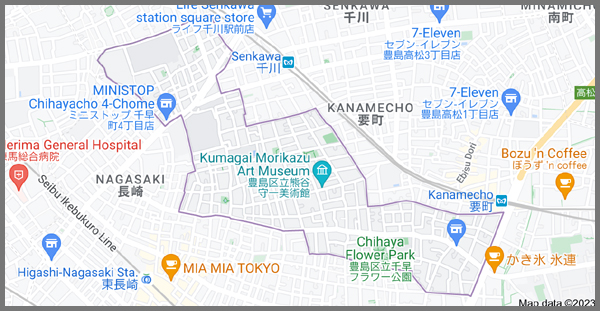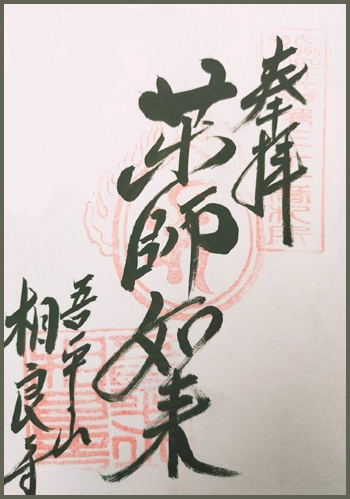https://gokurakuparadies.blogspot.com/2022/10/kannonji-ise-daimon.html
[ . BACK to DARUMA MUSEUM TOP . ]
. Japan - Shrines and Temples - Index .
. Buddhist Temples and their Legends .
. Ise Saigoku 33 Kannon 伊勢西国三十三所観音巡礼 Pilgrimage .
::::::::::::::::::::::::::::::::::::::::::::::::::::::::::::::::::::::::::::::::::::::::::::::::::::::::::::::::::::::::::::::::::::::::::::::::::::::::::::::::::::::::::::::
Kannonji 観音寺 Kannon-Ji, Daimon
恵日山 Enichizan, 観音寺 Kannonji
津市大門31 / Mie, Tsu city, Daimon
The Kannon statue is 聖観音 Sho Kannon .
The main statue is Amida Nyorai.
- quote
Enichizan Kannon-ji belongs to Shingon sect of Buddhism and is one of the three biggest Kannon temples in Japan.
The main statue is a hibutsu (hidden Buddhist statue) Shō Kannon (Sacred Kannon).
It also has many cultural properties in its possession.
Since its founding in 709 Enichizan Kannon-ji was very popular among people of Tsu.
Later on it also became popular all over the country as a Kannon that answers all prayers.
Many devoted believers were coming especially to pray for safety at the sea.
In Muromachi period (1336-1573) shogun 足利義教 Ashikaga Yoshinori (1394-1441), following the Emperor's command,
built a three-storied pagoda.
In the 16th Century the second "Great Unifier" of Japan 豊臣秀吉 Toyotomi Hideyoshi (1537-1598)
would visit Enichizan Kannon-ji and pray for a victory each time he was going to battle.
In the 17th Century since the times of the 2nd shogun of Edo period Tokugawa Hidetada (1579-1632)
the temple was protected and supported by all Tokugawa clan shoguns and daimyos of the Tsu province – the Tōdō clan.
It would be their special praying place until the 19th Century.
After the Meiji Restoration in 1868, which restored the actual power to the Emperor,
Enichizan Kannon-ji lost its protectors and went back to its original shape – a prayer ground for common people.
Since then temple became a popular center of worship and place of local entertainment.
The complex consists of:
観音堂、五重塔、仁王門、鐘楼堂、護摩堂、資料館、収蔵庫、手水屋形
the Kannon Hall, Five-storied Pagoda, the Main Gate (Niō Gate), the Bell Tower,
the Goma Hall (Goma/Homa fire ritual Hall), Archives, Storage Room, Hand Purification Place and 大宝院 the Daihō-in cloister.
Daihō-in was a cloister connected to the imperial family
and since the times of 後花園天皇 Emperor Gohanazono (1419-1471)
prayers for each Emperor were done within its walls.
Currently it stands on the western side of Kannon Hall and is used as temple's office building.
The main statue worshiped in the Main Hall is Buddha Amida (Buddha of Infinite Light) and it is known as
国府阿弥陀 Kokufu Amida (Amida of the Provincial Government).
There is an old saying:
If you don't pay your respects to Amida, then your Ise pilgrimage is only half-way done.
It suggests that Buddha Amida of Enichizan Kannon-ji was considered a Buddhist manifestation (honjibutsu)
of Shinto Goddess Amaterasu (the Goddess of the Sun).
- source : enichizankannonji ...
..............................................................................................................................................
shuin 朱印 stamp
omamori お守り amulet
.......................................................................
- - - - - Reference of the temple
- source : enichizankannonji ...
- reference source : isekannon.jp/english ... -
- reference source : nippon-reijo.jimdofree ... -
::::::::::::::::::::::::::::::::::::::::::::::::::::::::::::::::::::::::::::::::::::::::::::::::::::::::::::::::::::::::::::::::::::::::::::::::::::::::::::::::::::::::::::::
This temple is Nr. 14 of the pilgrimage
. Ise Saigoku 33 Kannon 伊勢西国三十三所観音巡礼 Pilgrimage .
. Kannon Bosatsu 観音菩薩 Avalokiteshvara .
. Shō Kannon 聖観音 / 正観音 Sho Kannon / 聖観世音菩薩
::::::::::::::::::::::::::::::::::::::::::::::::::::::::::::::::::::::::::::::::::::::::::::::::::::::::::::::::::::::::::::::::::::::::::::::::::::::::::::::::::::::::::::::
. Temples with legends .
. Japanese Legends - 伝説 民話 昔話 – ABC-List .
. Japan - Shrines and Temples - Index .
[ . BACK to DARUMA MUSEUM . TOP . ]
[ . BACK to WORLDKIGO . TOP . ]
- - #kannonji #daimon #isesaigoku ##isesaikoku ##isekannon -
::::::::::::::::::::::::::::::::::::::::::::::::::::::::::::::::::::::::::::::::::::::::::::::::::::::::::::::::::::::::::::::::::::::::::::::::::::::::::::::::::::
https://gokurakuparadies.blogspot.com/2022/10/kannonji-ise-daimon.html
.
Kannonji Ise Daimon
. Japan - Shrines and Temples - Index .
. Buddhist Temples and their Legends .
. Ise Saigoku 33 Kannon 伊勢西国三十三所観音巡礼 Pilgrimage .
::::::::::::::::::::::::::::::::::::::::::::::::::::::::::::::::::::::::::::::::::::::::::::::::::::::::::::::::::::::::::::::::::::::::::::::::::::::::::::::::::::::::::::::
Kannonji 観音寺 Kannon-Ji, Daimon
恵日山 Enichizan, 観音寺 Kannonji
津市大門31 / Mie, Tsu city, Daimon
The Kannon statue is 聖観音 Sho Kannon .
The main statue is Amida Nyorai.
- quote
Enichizan Kannon-ji belongs to Shingon sect of Buddhism and is one of the three biggest Kannon temples in Japan.
The main statue is a hibutsu (hidden Buddhist statue) Shō Kannon (Sacred Kannon).
It also has many cultural properties in its possession.
Since its founding in 709 Enichizan Kannon-ji was very popular among people of Tsu.
Later on it also became popular all over the country as a Kannon that answers all prayers.
Many devoted believers were coming especially to pray for safety at the sea.
In Muromachi period (1336-1573) shogun 足利義教 Ashikaga Yoshinori (1394-1441), following the Emperor's command,
built a three-storied pagoda.
In the 16th Century the second "Great Unifier" of Japan 豊臣秀吉 Toyotomi Hideyoshi (1537-1598)
would visit Enichizan Kannon-ji and pray for a victory each time he was going to battle.
In the 17th Century since the times of the 2nd shogun of Edo period Tokugawa Hidetada (1579-1632)
the temple was protected and supported by all Tokugawa clan shoguns and daimyos of the Tsu province – the Tōdō clan.
It would be their special praying place until the 19th Century.
After the Meiji Restoration in 1868, which restored the actual power to the Emperor,
Enichizan Kannon-ji lost its protectors and went back to its original shape – a prayer ground for common people.
Since then temple became a popular center of worship and place of local entertainment.
The complex consists of:
観音堂、五重塔、仁王門、鐘楼堂、護摩堂、資料館、収蔵庫、手水屋形
the Kannon Hall, Five-storied Pagoda, the Main Gate (Niō Gate), the Bell Tower,
the Goma Hall (Goma/Homa fire ritual Hall), Archives, Storage Room, Hand Purification Place and 大宝院 the Daihō-in cloister.
Daihō-in was a cloister connected to the imperial family
and since the times of 後花園天皇 Emperor Gohanazono (1419-1471)
prayers for each Emperor were done within its walls.
Currently it stands on the western side of Kannon Hall and is used as temple's office building.
The main statue worshiped in the Main Hall is Buddha Amida (Buddha of Infinite Light) and it is known as
国府阿弥陀 Kokufu Amida (Amida of the Provincial Government).
There is an old saying:
If you don't pay your respects to Amida, then your Ise pilgrimage is only half-way done.
It suggests that Buddha Amida of Enichizan Kannon-ji was considered a Buddhist manifestation (honjibutsu)
of Shinto Goddess Amaterasu (the Goddess of the Sun).
- source : enichizankannonji ...
..............................................................................................................................................
shuin 朱印 stamp
omamori お守り amulet
.......................................................................
- - - - - Reference of the temple
- source : enichizankannonji ...
- reference source : isekannon.jp/english ... -
- reference source : nippon-reijo.jimdofree ... -
::::::::::::::::::::::::::::::::::::::::::::::::::::::::::::::::::::::::::::::::::::::::::::::::::::::::::::::::::::::::::::::::::::::::::::::::::::::::::::::::::::::::::::::
This temple is Nr. 14 of the pilgrimage
. Ise Saigoku 33 Kannon 伊勢西国三十三所観音巡礼 Pilgrimage .
. Kannon Bosatsu 観音菩薩 Avalokiteshvara .
. Shō Kannon 聖観音 / 正観音 Sho Kannon / 聖観世音菩薩
::::::::::::::::::::::::::::::::::::::::::::::::::::::::::::::::::::::::::::::::::::::::::::::::::::::::::::::::::::::::::::::::::::::::::::::::::::::::::::::::::::::::::::::
. Temples with legends .
. Japanese Legends - 伝説 民話 昔話 – ABC-List .
. Japan - Shrines and Temples - Index .
[ . BACK to DARUMA MUSEUM . TOP . ]
[ . BACK to WORLDKIGO . TOP . ]
- - #kannonji #daimon #isesaigoku ##isesaikoku ##isekannon -
::::::::::::::::::::::::::::::::::::::::::::::::::::::::::::::::::::::::::::::::::::::::::::::::::::::::::::::::::::::::::::::::::::::::::::::::::::::::::::::::::::
https://gokurakuparadies.blogspot.com/2022/10/kannonji-ise-daimon.html
.
















































